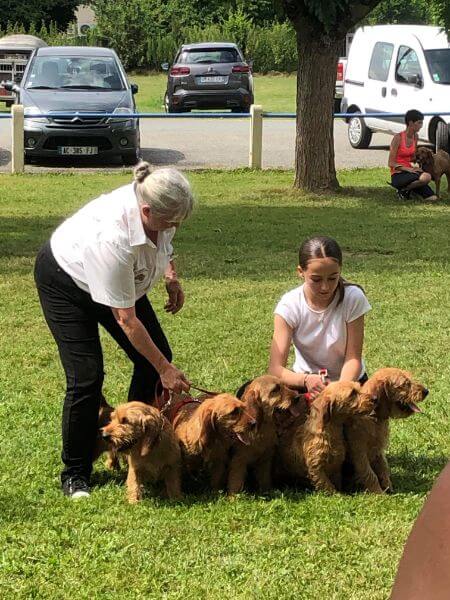
Home » Chasse d’abord!

Five Basset Fauve de Bretagne Club of America members traveled to Villeréal, France, to attend the French club’s National on July 17-18, 2023. It is always a privilege to observe Fauves being evaluated in their country of origin by esteemed breeder-judges. Because I have been to the event numerous times and shadowed judges in the past, the goal this time was to introduce others to the event and to help them build relationships that I have enjoyed for years. It was once again exciting to see so many quality Fauves from all over Europe and the UK, with an entry of over 350 Basset and Griffon Fauves.
FCI and AKC shows are different, with the European shows generally being more relaxed but with judging being very thorough. Upon arrival at the show grounds, this year at a park in Southern France, owners placed their packs of dogs in 10×10 chain link pens. Crates were rarely used. Rows of pens were provided by the club. The dogs were not overly groomed and many appeared to have just been brought in from the field after hunting. Packs of Fauves were walked to the tall grass or woods to eliminate, often off-leash. French owners have high expectations about their dogs being under control—and their dogs comply.
Dogs are required to be at least a year old to compete beyond the class level. There were several very nice young (9-18 months old) Fauves entered in the Juvenile Class, but these dogs did not compete outside of their class. All dogs upon entering the ring had their tattoo or microchip checked and confirmed as the entered dog. Each dog was measured with the wicket for height, and occasionally for length. Basset Fauves are to be only slightly longer than tall, and the ideal ratio, height to length, is 1:1.2. They are not necessarily the smallest of all the Basset breeds, but they are the shortest-backed.

While being judged, critiques were dictated and recorded by the ring steward. Exhibitors left the ring with a document signed by the judge, and their dog rated either Excellent, Very Good, Good, Sufficient, Disqualified, or Cannot Be Judged. Only dogs with Excellent ratings were brought back into the ring to compete for a First through Fourth place. These placements were determined by a panel of judges.
Dogs were examined for overall head appearance, eye color, pigment, ear set and length, bite, shoulder layback, tail length and set, and testicles. Fronts were examined by lifting the front feet off the ground, holding the elbows and dropping the dog back to the ground. This allowed judges to observe a natural foot placement. A straight front is preferred, but a slight turnout is acceptable. Only a small patch of white on the chest is tolerated. We observed a very nice dog get eliminated due to the amount of white on its chest.
Dogs were frequently faulted for having long, skinny tails. Generally, ear set, fold, and lengths were very good. We did observe several dogs with light eyes and pigment, and were informed these were items being addressed by breeders. Toplines were not always level, with several very nice dogs having a slight rise over the loin that was just well-muscled hips. Balanced fronts and rears allowed Fauves to move freely, with minimal effort. This is essential for the dogs to be able to hunt all day long.

I especially enjoyed watching the Working Dog Class. These are dogs with hunting titles, demonstrating beauty and brains, and who flaunt the saying: “No need to hunt with an ugly dog!” We also enjoyed the consistency in the packs of five dogs, and the Brood Bitch and Stud Dog Classes.
The Basset Fauve de Bretagne Club of America has certainly grown and focused since becoming the official AKC breed club 10 years ago. We look forward to preserving, protecting, and advancing the breed in the future here in the US. We plan to take more club members back to France in the future to observe judging to the Breed Standard and to observe Fauves competing in the field. As the French Fauve de Bretagne club’s motto states, “Chasse d’abord!” Hunting First!
